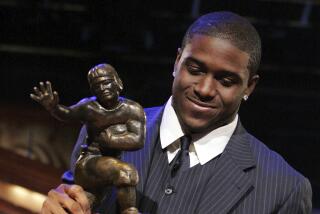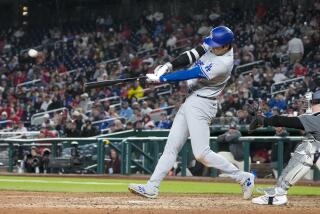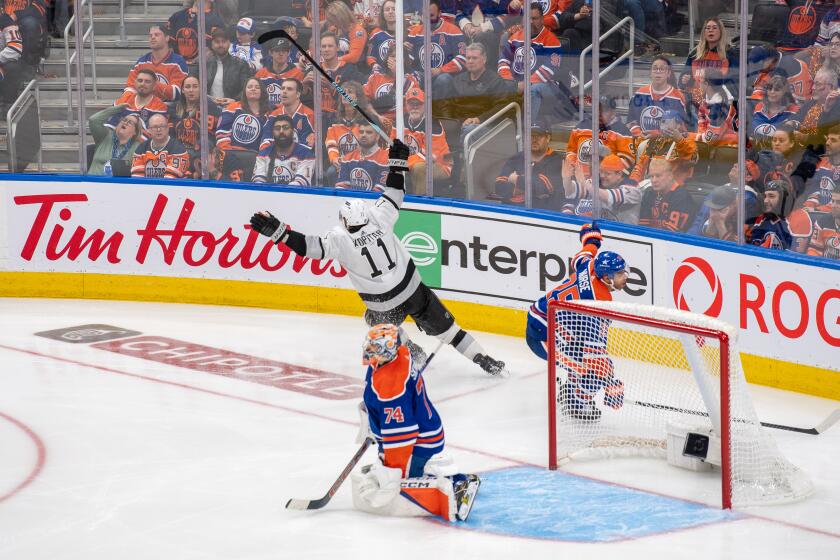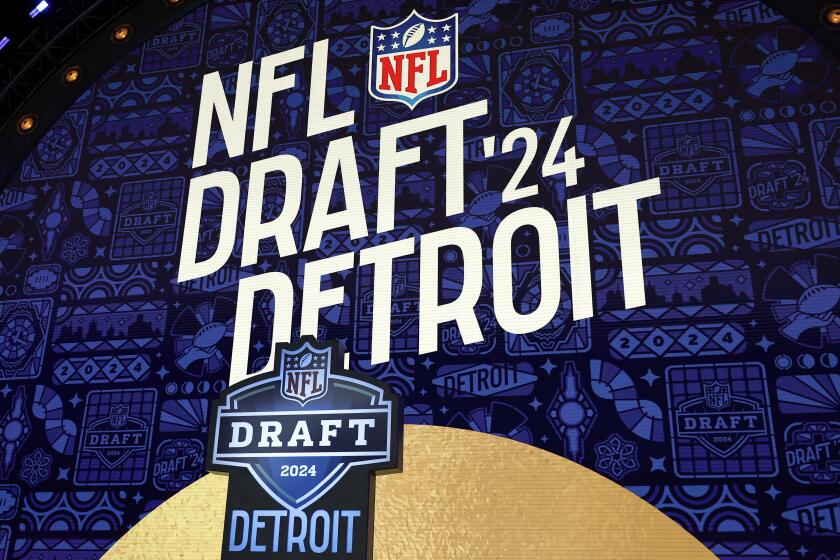COMMENTARY : Mikan Was the Giant of His Day
George Mikan likes to tell about being the good-natured giant of his day, of the time he made the mistake of bringing an offensive rebound low enough for Red Holzman to tie him up. So they had a jump ball at Mikan’s free-throw line -- little Red against big George. “The referee tossed the ball up and I tipped it into the basket; two points,” Mikan said. Ha, ha. Holzman called him a big (unprintable). Ha, ha again. In the enormous boom of basketball, the game never has properly honored its roots. At the recent “Night of 100 Stars,” Mikan was introduced, limped across the stage and waved to a crowd of mostly unknowing stares.
“Who’s he?”
He’s the Babe Ruth of basketball, that’s all. Except that they didn’t move the fences back and make them tall for Ruth the way they did for Mikan. He changed the course of basketball as a player. He wore No. 99. It was only 35 years ago.
The National Basketball Association was called the Basketball Association of America for two years before the merger. Mikan played in the National Basketball League, which was poo-pooed because it had teams in Sheboygan, Wis., and Anderson, Ind.
It had Mikan, who invented the big man. He was 6-foot-10 and as broad at a time when hardly anybody else was. “He could move down the court,” Bob Cousy recalls. “He’d get down and wipe you out at his end.”
Mikan’s Minneapolis Lakers won the NBL championship and then earned five titles in their first six seasons in the merged NBA. It was like the Cleveland Browns joining the haughty National Football League and doing the same thing they did to the All-America Conference. The one year the Lakers lost, in 1951, was when Mikan had a broken leg and Rochester with Holzman beat them. “The doctors taped a plate on it for the playoffs,” Mikan said. “I played all right, scored in the 20s. I couldn’t run, sort of hopped down the court.”
He says if you watch the old black-and-white films you’ll see that the game hasn’t changed all that much -- except they used the two-hand set shot and the jump shot was still being invented and all the black players were still with the Harlem Globetrotters. That’s all.
And you won’t see a dunk. It was illegal because of him, he says. In college, at DePaul, he would bat the ball out of the basket, so they instituted rules against goaltending, and included offensive goaltending. “We used to dunk in pregame practice, not in the game,” Mikan said. “If they didn’t get rid of that rule, there’d be no Michael Jordan.”
Because of Mikan the three-second lane was widened from 6 feet to 12 feet, and to the present 16 feet. And the shot clock was created.
In 1950 the Fort Wayne Pistons held the ball against the Lakers, beating them 19-18 in the lowest-scoring game in NBA history. “They wouldn’t play,” Mikan said. The 24-second rule came in three seasons later. “That game was the biggest cause,” he said.
He also was the first commissioner of the red-white-and-blue ABA. The three-colored ball came and went with his league, but the three-point shot stayed. Mikan might have changed the history of the game again if he’d been more effective. Uniondale might have been the capital of the game.
Kareem Abdul-Jabbar was graduating from UCLA as Lew Alcindor and Mikan’s owners got together to draft Alcindor and share the cost for the New York franchise, which was the Nets en route from Commack to the Nassau Coliseum. “We felt if we could get accepted in New York, we’d be accepted anywhere,” Mikan said. “The secondary plan was to have each team sign one top player from the other league. They wouldn’t follow my direction.”
They did steal Rick Barry and prepared a check for $1 million for Alcindor, who said he wanted to play in New York or California. He said that he’d take just one offer from each league. “One million was beyond anybody’s imagination,” Mikan said. “It was a shock when he turned us down and went to Milwaukee. We thought a million was a pretty good deal in 1968.” We can only guess what would have evolved if Abdul-Jabbar had played his 19 seasons with the Nets.
Mikan left his mark as a player. “We were playing Rochester and when I got a defensive rebound, Les Harrison wanted Holzman to stand right in front of me so I couldn’t get upcourt. The first time, I knocked Red 15 feet. He yelled to Harrison, ‘If you want it done, do it yourself.”’
I’d take my chances with this team against anybody: Jerry West, Oscar Robertson and Bob Cousy at guard; Elgin Baylor, Bob Pettit and Bill Russell at forward and Wilt Chamberlain at center.
Today Cousy would be John Stockton. An assist was an assist then; none of these assists for passing out for a three-point shot.
“No question they’d do fine,” Knicks assistant Paul Silas said. “Those guys were a lot more fundamentally sound than players of today. Today there’s a lot of flash. These guys throw passes behind their backs; what a pass is supposed to do is get the ball from one point to the other. The two-hand chest pass is still the best pass.”
Mikan said that he loves the present game; he buys the excesses as so much show business. Silas and Cousy are not quite so permissive.
“The game hasn’t changed, the athlete has changed,” Cousy said not too long ago, citing the 6-7, 280-pound football player who runs 40 yards in four seconds. “In basketball you see 7-foot guys doing things of a 6-footer. We shot 40 percent; that wouldn’t get you by in Division III.”
Cousy popularized the flash that consumes so much of today’s game, except that he used the flash when the orthodox wouldn’t do. He dribbled behind his back the first time in a game because he was being overplayed. “Today every 12-year-old in the schoolyard is doing it, probably better,” he said. “But they do it bringing it upcourt to no advantage.”
More to Read
Get our high school sports newsletter
Prep Rally is devoted to the SoCal high school sports experience, bringing you scores, stories and a behind-the-scenes look at what makes prep sports so popular.
You may occasionally receive promotional content from the Los Angeles Times.






